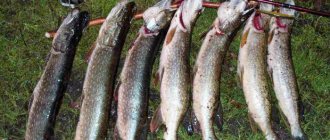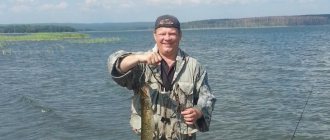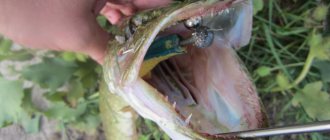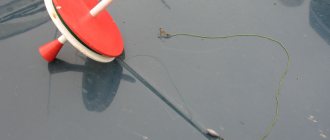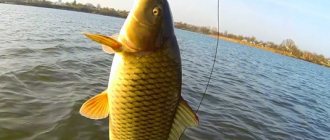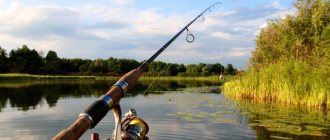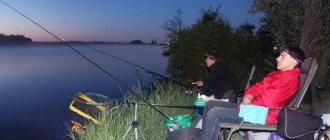Moscow, 02/16/2021, 11:46:31, editorial office PRONEDRA.RU, author Inna Mordasova.
Few people think about legislation when going fishing. But, as you know, ignorance of the law does not exempt you from responsibility. Therefore, before putting away hooks, uncovering spinning rods and digging for worms, you should study where, how, what and when it is allowed to fish. So that later there will be no excruciating pain for a thinner wallet and a ruined vacation.
Zherlitsa is one of the most effective methods of catching pike. At first glance, it may seem that everything is extremely simple - you bait with live bait, lower it to the bottom and turn on the “standby mode”. If everything is so simple, then why do funny things happen so often on the ice? Some fishermen, after installing the girders, begin to actively catch pike, while other fishermen do not see a single bite for the whole day.
What are mugs?
A pike circle is a kind of summer bait that can be set freely floating or installed permanently with an anchor. You can tie it to reeds and branches. Live bait is used as bait.
The design of the mug is simple, so you can make it yourself at home. It consists of several parts:
- the body or the circle itself. A small round platform made of foam or light wood. 2.5-3 cm thick and 15-20 cm in diameter. A special recess is made at the end around the entire perimeter into which the fishing line is placed. On two opposite sides there are special cuts for fixing the fishing line, and in the very center there is a hole with a diameter equal to the thickness of the antenna. For ease of observation, the body is painted white on the bottom and red on the top;
- antenna. Insert into the center of the mug so that most of it sticks up. A cut is made at the tip through which the fishing line will pass. It is painted in two colors: the bottom is white, the top is red. Performs two functions. The first one serves as a bite alarm if the antenna goes under water. Having turned the circle over, you should check the tackle for the presence of a predator. Secondly, it regulates the mug’s sensitivity to weather conditions. In strong winds and large waves, the antenna should be recessed a little so that it does not turn over spontaneously;
- fishing line Usually monofilament line is used. The length of the entire tackle rarely exceeds 20-25 m, and at such a distance the stretch of the monofilament is not significant. In addition, when playing, the braided line can cut hands unprotected by gloves;
- sinker. Since the size of live bait rarely exceeds 10 cm and the weight is 100 grams, the sinker is made weighing up to 15 grams. It is not worth attaching it tightly to the fishing line - its weight will alert the spotted predator, and it will simply spit out the bait. It is better to use a sliding mount, which will be fixed at the bottom with a swivel;
- a steel or fluorocarbon leash - any other fish will bite. The length depends on the proximity of vegetation, the condition of the bottom of the reservoir, and the relief. Usually the length does not exceed 40 cm. This allows the bait fish to move quite freely, but does not allow it to go into thickets or snags;
- hook. Single or tee - at the request of the fisherman.
The tackle is installed quickly, without tricks or problems, even in a strongly rocking boat. Live bait is attached in two ways. If the current is not strong, the hook is caught on the gills. In strong currents, they are placed under the dorsal fin.
conclusions
In order for pike fishing with a circle to be successful, you should not only choose the right fishing location, but also fish taking into account the peculiarities of the bite and the nuances of using this tackle in different places. Many people prefer to make their own equipment or use ready-made parts of the equipment, adding their own modifications to them along the way. At the same time, one should also take into account the behavioral characteristics of different types of live bait, both for the correct bait and for choosing the depth of immersion, especially in the hot summer months.
In addition, the fisherman needs to know how to correctly place charged mugs in order to quickly respond to each bite. Hooking a pike must be done decisively, and fishing must be done with patience. It must also be taken into account that using more than five circles per person is prohibited.
Catching this toothy prey is akin to a sporting competition. And this is especially true for mug fishing. The most resilient, skillful and cool-headed, quick-decision-making fishermen win. Properly chosen tactics and knowledge of the features will bring not only a rich catch, but also great pleasure.
Principle of operation
A correctly charged circle drifts with the flow or stands in one place. When the pike is tempted by the scurrying baitfish and grabs it, a jerk occurs, and the fishing line passed through the upper end of the antenna turns the circle upside down with its white bottom. This serves as a signal to the fisherman that it is time to swim closer. At this time, the predator, having tasted the bait and not feeling any resistance, swallows the bait. She may try to go to her usual ambush place. In this case, the circle will begin to rotate, unwinding the fishing line. Self-hooking is quite possible, so you need to hurry.
Special fishing
Catching pike with mugs in a fairly strong current has its own nuances that you definitely need to know. For example, to prevent the tackle from being blown away, it must be anchored. For a homemade version, you can use a piece of fishing line, one end tied to the mast thickening, and the other to the reed thickets. If there is a fear that the bait may hide in the thickets, then you need to tie two pieces of fishing line to the circle, tightening them in opposite directions and attaching them at the base of the pin with a loop or wire ring.
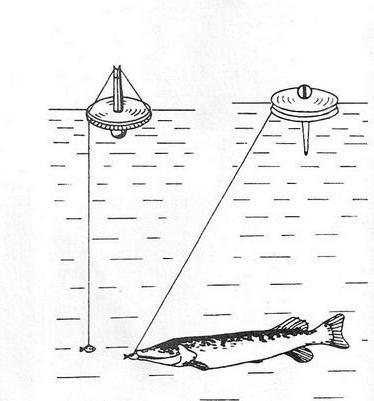
Fishing for large bottom-dwelling predators with this gear works well in shallow areas - wide and extended river reaches with a depth of four to six meters or in areas of lakes with shallow depth and calm currents. However, along the trajectory of the circle’s movement there must be favorite places for the pike - stones or holes, as well as flooded trees, etc., where it prefers to hunt.
When bitten, the disk, the sides of which are painted in different colors, turns upside down with the light part and begins to rotate, unwinding the fishing line. Then there is a pause in movement: at this time the prey swallows the bait. After the bite, the pike tends to hide in a shelter, which is why the rotation of the circle resumes with renewed vigor. At this point, the angler needs to either pull the prey into the boat, or, when it begins to resist, alternate between pulling and releasing.
Place and time of the circles
Experienced fishermen are well aware of how pike behavior changes depending on the time of year. The spotted one is an ambush predator and prefers to stay in one place for a long time, waiting for suitable prey to appear within striking distance. Therefore, mugs should be placed in such places.
Spring
Having spawned, the pike is in no hurry to leave the place chosen for procreation. And it spawns at shallow depths, where the water has already warmed up to 7-10 degrees and where there are natural barriers in the form of snags or grass. There are a lot of all kinds of small fish here, which also came to warm up after a long cold winter and are not averse to eating pike caviar. The toothy one will stand here in ambush for a couple of weeks.
Here she does not so much protect her offspring as she simply eats and gains strength after spawning. Feeling stronger, the pike will leave the spawning area and return to its usual hunting grounds: holes, riffles, flooded trees. At this moment, she begins to really eat, and she attacks any suitable prey throughout the daylight hours.
Summer
In summer, pike begin a so-called closed food cycle. In order to replenish strength and energy, she needs to eat tightly. You have to be in constant motion, wasting strength and energy. The toothy one is constantly looking for food at this time, so fishing with mugs is very productive. It makes sense to place the tackle in the place where the fish fry, fleeing from the predator, begin to jump out of the water in panic.

Autumn
Along with a decrease in water temperature, the activity of pike increases proportionally. The spotted one strives to gain at least some fat before the long winter, when there will not be much food. At this time, pike hunt near edges, snags, in reeds and near other natural obstacles at a depth of 3-8 m. The autumn zhor lasts until ice forms and is highly dependent on atmospheric pressure and the phases of the moon. As pressure increases, pike activity increases significantly.
Winter
In winter, pike are caught from under the ice using a variety of circles - girders. The principle of operation and installation of the gear is identical. But unlike the antenna, which turns the circle over when it bites, there is a flag on the rod, which, when straightened, signals that a bite has occurred.
How to fish with mugs
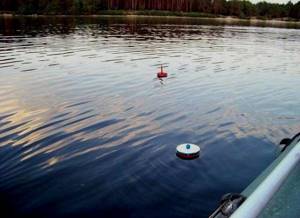
Before starting fishing, they study the bottom topography of the water area, identifying promising points where there is a high probability of fish parking. It is imperative to take into account the direction and strength of the wind on the day of fishing to understand in which direction and how quickly the circles will move.
The fishing scheme is as follows:
- The fisherman places the circles on the same line, maintaining a distance of 5–25 meters between them.
- Having arranged all the gear, you need to position yourself behind them so that it is convenient to control each live bait.
- As the circles move, the boat also moves.
We recommend reading: How to tie a jig to a winter fishing rod
After passing a given area, the live bait is removed. The fisherman either installs them again or changes the location if there are no bites.
Installation of equipment for fishing conditions
Various factors influence the equipment of a circle for specific fishing conditions:
- the presence of a current and its strength;
- the potential size of pike that can attack the bait;
- aquatic vegetation and its density;
- depths at the fishing site;
- relief and nature of the bottom;
- the presence of snags.
As the main fishing line, it is enough to take about 20 meters of monofilament with a thickness of 0.4–0.5 mm with a breaking load of 7–8 kg. The leash is made of fluor or a special soft woven material that is resistant to abrasion. It is tied through a swivel, clasp or winding ring.
Sinkers are used in different shapes and types. For standard gear, it is enough to have ordinary “olives” of suitable weight and small pellets. For stationary circles, a variety of loads can be used, sometimes even a banal brick is used.
The hook can be single, double or triple. Its size depends on the potential weight of the predator and the live bait used. It must be durable and withstand powerful jerks of the pike when fishing. Be sure to keep an eye on its sharpness!
Selection of live bait and methods of baiting them
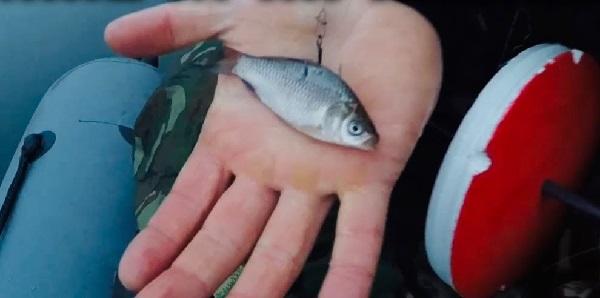
To successfully catch pike, you must use fresh bait. The best live bait is juvenile fish caught right on the pond where you plan to hunt for the toothy beast. They represent its natural food supply and will not arouse suspicion.
Of the fish species used for pike fishing, it is better to focus on:
- crucian carp;
- tench;
- rudd;
- perch;
- roach;
- guster.
On a note! When fishing with mugs, pike rarely pay attention to the color and body shape of live bait, so their vitality comes first.
Most often, the fish is hooked by hooking it behind the back. There are options for fixing the bait by the lips or through the gills.
How to place mugs correctly
Arranging circles on a pond will not cause difficulties even for novice pike fishermen. The angler needs to move the boat consistently. You cannot rush around the water area chaotically, scattering gear everywhere. Initially, promising points located close to each other are selected.
Tip: The minimum distance between circles is 3 meters. Otherwise they can easily get mixed up.
When fishing with standard circles in a water area without a current, it is better to place the gear in one line. Then they will move evenly under the influence of the wind, will not get tangled, and will be comfortable to follow and respond to pike bites.
Features of fishing in different seasons
Each season leaves its mark on the behavior of pike. It changes activity, locations, and nutritional preferences. In cold water the predator gravitates towards the bottom horizon, in warm water it rises higher. It is also affected by the direction and strength of the wind, air temperature, precipitation, and the phase of the moon.
We recommend reading: The best wobblers for pike perch
in spring
In the spring, they begin to hunt in circles after the spawning ban is lifted. Pike are searched for in flooded shallow areas up to 2 meters deep. Peak activity of the predator is in the first half of the day. There are still almost no fish found in the current.
In summer
From June to August, the spotted beast feeds in the upper and middle layers of water. Prefers various oxbow lakes and backwaters. It stands near the coastal strip of algae, on the edges, in the return paths and pits. Large individuals occupy channel slopes, holes, and rifts. Peak activity is early morning and evening.
in autumn
From the second half of September, pike begin to experience a real autumn feast, which continues until mid-November with short-term declines. The predator moves away from the shore, occupying edges, dumps, single snags, and pits. Feeds all day. Closer to winter, its activity shifts to midday.
How to properly equip a circle
The length of the entire fishing line on the circle is calculated by the formula: depth at the fishing site + 5-10 m, depending on the presence of thickets, snags and other natural obstacles nearby. Pike can tangle the tackle so much that you have to break it off. A steel or fluorocarbon leader is also not necessary, especially if the pike is inactive and there is a chance that pike perch and large perch might bite. The use of single, double or treble hooks depends on the type of bait fish available. A small gudgeon or brush can be attached to a single hook, but a white bream, crucian carp and silver bream can be attached to a double or tee hook.
Zywiec
Live bait should be chosen from those species of fish that are found in a given reservoir, but taking into account the fishing location and the expected size of the pike. When setting circles over significant depths away from thickets of reeds or reeds, the type of baitfish does not matter much, the main thing is to maintain the size. It should not exceed 10 cm, but sometimes, when there are no fry in the reservoir, larger live baits are also released.
When fishing for pike living among reeds or in thickets of grass, do not use loaches, loaches and crucian carp as live bait, because the tackle can become tangled. At the first opportunity, these types of fish will try to hide in the thickets, pulling the fishing line along with them. In such places it is better to use brushes, white breams, rudd or silver bream. Dace are especially good for this role. They do not like thickets, are quite hardy and very mobile.
What is a pike fishing circle?
A circle for pike is a live bait tackle for open water. Consists of simple elements:
- Directly the tackle is in the shape of a puck. Made of dense floating material - wood, foam.
- Main line with a breaking load of at least 5 kg. Wraps around a circle.
- Equipment. It includes a fluorocarbon or soft leader material, a weight and a hook.
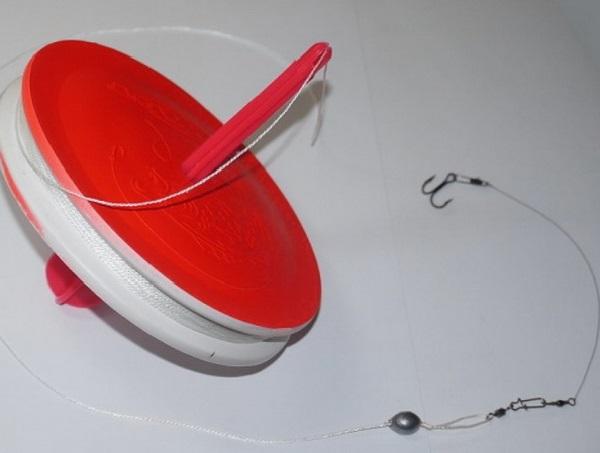
An important element of the circle itself is the mast. Its length is approximately equal to the diameter of the circumference of the tackle body. At one end there is a spherical head on it, which ensures that the tackle turns over when a predator bites.
Note! As a rule, the circle is painted in a bright color, which makes the bite visible from a great distance.
Sometimes plastic bottles, cylinders and other available materials are used as the body of the circles. This has almost no effect on the effectiveness of fishing, although it makes the process less comfortable, limiting it in the fishing area due to the worse visibility of the gear.
How do mugs work for pike?
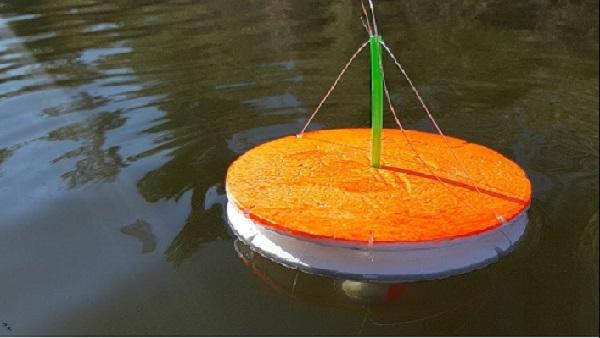
The fisherman places the bait on the tee and places the loaded gear around the water area. The line is fixed so that live bait cannot reel it in. An inverted circle moving to the side signals that a pike bite has taken place.
The mugs are placed from the boat. The fisherman places them so that they are constantly under his visual control and, in the event of a bite, he can quickly get to the gear, hook and land the prey.
Is it allowed to catch pike with mugs (prohibitions, restrictions)
The circle is a legal tackle, no different from the usual live baits, baits, fishing rods and spinning rods. You can fish with it in all regions in different bodies of water, where not only pike is found, but also large perch, pike perch, burbot, catfish and asp.
Depending on the region, the allowed number of mugs is 5–10 pieces per angler. Wherein:
- you can equip the circle with one double, tee or regular hook;
- Fish listed in the Red Book as an endangered species cannot be used as live bait;
- It is forbidden to leave placed gear unattended.
Recommended reading: Texas spinning rig
Naturally, fishing with mugs is strictly prohibited during the spawning period, which occurs in the second half of March to mid-May.
Varieties of circles for flow and still water
Fishing gear:
- standard (moving);
- stationary (equipped with an anchor).
The first ones are relevant in still water. These are lakes, fronds, quarries, ponds, oxbow lakes and backwaters. The latter are used on rivers where there is a current, less often when fishing in windows of aquatic vegetation.
Standard
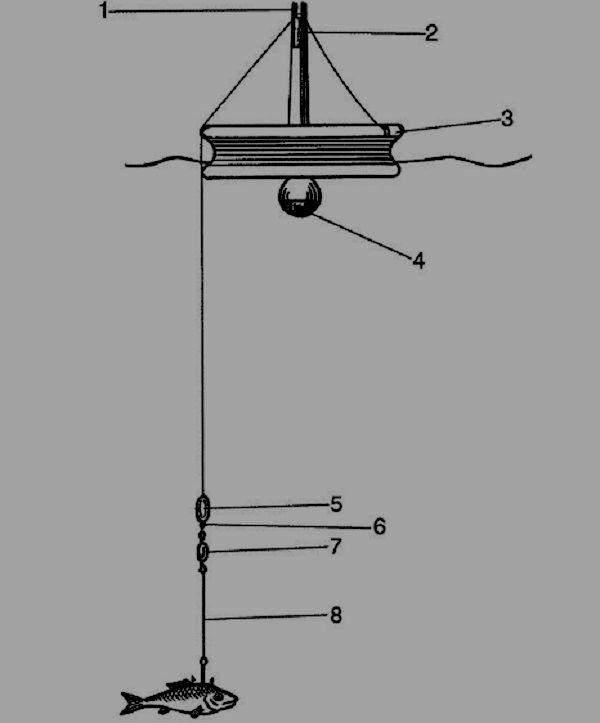
Freely moving mugs are the basic gear with which it is recommended to master this direction of fishing for spotted beasts in still water. Their device looks like this:
- circle;
- main line;
- leash;
- sinker;
- hook.
The fisherman needs to equip the tackle, attach the bait and send it to a given point. In this case, the circle will constantly move around the water area due to the wave, or the live bait itself can swim to the side with it.
A standard circle allows you to quickly explore a location for the presence of active pike. It is easy to install it from a boat at a given point, check and change the bait for fresh one, fish out a predator that has sat on the hook, and remove it at the end of fishing.
Stationary
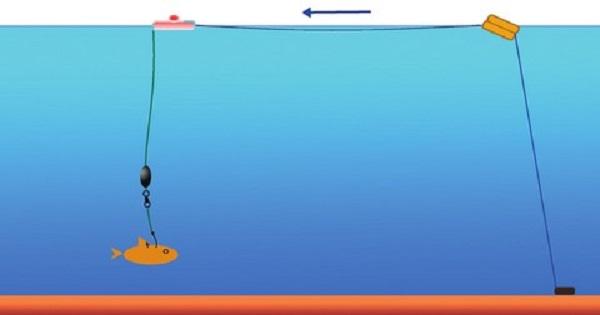
To fish in a current, the circle needs to be anchored, otherwise the water flow will quickly carry the gear away from the promising area, making it impossible to properly monitor it. The fishing efficiency in this case will be almost zero.
The most common type of flow mug is equipped as follows:
- A triple swivel is tied to the main thread.
- We attach a fluorocarbon or monofilament fishing line to the bottom loop. Its length can be 0.5–1.2 meters.
- We tie a weight to the free end of the leash so that the equipment is held at a given point and is not carried away by the stream.
- All that remains is to attach a fluorocarbon bend with a hook to the middle loop of the swivel.
The proposed installation is suitable for weak and moderate currents. In medium and strong flows, it is recommended to equip pike fishing circles with the so-called “machine”. The circle, mounted as a standard one, is tied to a piece of floating wood, which is fixed to the bottom using a lead weight or brick. This solution ensures a stable position of the gear. It can be safely installed on channel rifts and dumps, in holes and long ditches, in the area of snags and deep rubble.
Fishing technique and tactics
The Law on Fisheries and Recreational Fishing prohibits the use of more than 5 circle-type gear per angler. This is quite enough to fish a significant area. It is necessary to consider the distance between the circles during installation, based on current speed, wind and bottom topography.
On shore, you should make sure that the gear is in good condition and put it in working condition. Having arrived at the fishing spot, measure the length of the fishing line, secure the bait on the hook and carefully lower the equipped tackle into the water with a slot to fix the fishing line with the flow. After swimming a meter or one and a half, the circle will unfold and thereby further secure the fishing line in the slot. This will not affect the fish’s bite, but it will protect against spontaneous upheaval.

The next circle should be installed at a distance of at least 20 m. If you imagine that the pike has bitten and managed to unwind the entire supply of fishing line from the circle, then it can easily get tangled in the nearby tackle, and you will have to untangle the fishing line.
Having placed the allowed number of circles, you should sail to a certain distance and from there observe the behavior of the antennas. If the circle turns over and begins to rotate, it means that the pike has grabbed the bait. In this case, there is no need to rush, but it is necessary to direct the boat in the right direction. There is no point in hooking when unwinding the fishing line. It is better to wait until it stops until the pike has actually swallowed the bait.
Fishing for a particularly large trophy must be done carefully. An extractor is a necessity, since a pike can swallow live bait deeply enough, and it will be impossible to remove the hook with bare hands, given the number and sharpness of pike teeth.
It is advisable to have a special tank for storing caught fish or kana with a grid.
☸ Features of catching pike with mugs
The main advantage of this method is the absence of direct contact between the fisherman and the gear, which significantly increases the chances of success. All that is needed is to place the circles in places where predators are expected to gather: in deep areas of a reservoir with complex bottom topography (pits, edges and other irregularities), in snags, next to reed islands, and so on. In gentle currents and on windless days, you can use mobile devices (with a light load), which slowly move around the reservoir and “look” for fish themselves.
Such fishing is impossible without a watercraft. Nobody catches one or two mugs. Usually there are a lot of them, they are located far from each other, and not everything is visible from the shore. In order to react to a bite in time, the angler needs to keep them in sight, and this can only be done while nearby, in a boat.
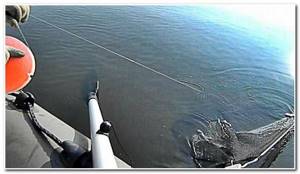
How to make a circle with your own hands
- A circle with a diameter of 150−200 mm is sawn or cut out of a piece of foam plastic or a board 15−20 mm thick;
- a hole with a diameter of 6-8 mm is drilled in the center;
- at the end, along the entire perimeter, a recess of 9-12 mm is made, into which the fishing line will fit;
- in the upper part, on opposite sides, two symmetrical cuts are made to fix the fishing line;
- The antenna is made of wood. Its length should correspond to the diameter of the circle. The end that will be on top is ground down in a cone shape, and an incision is made in it under the scaffolding;
- All that remains is to paint the circle itself, the antenna, and equip it with fishing line.
The sinker, along with the leash and hook, can be installed directly on the pond, depending on the fishing conditions.
Equipment for clubs
Equipping mugs for pike fishing does not imply any complex actions; everything has long been known and is very simple. You need to choose a fishing line that will be the main one, it is best to use 0.3-0.5 mm in diameter. This fishing line must be wound around a circle; its length depends on the depth of the reservoir and usually exceeds it by 7-8 meters.
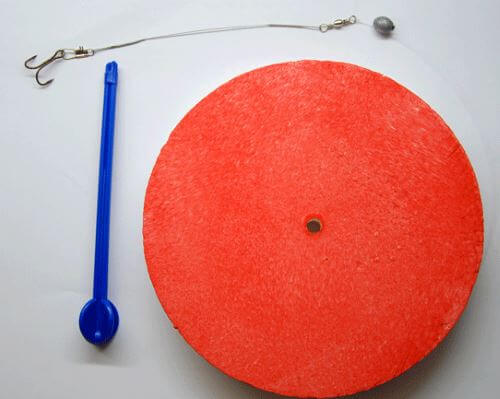
You can secure the fishing line to the mug using a regular loop. Be sure to add a small sinker to the tackle, weighing about 10-15 grams. It is best to use the well-known sliding olive. As a stopper, you can use a classic stopper assembly or use silicone stoppers.
You need to attach a swivel to the end of the fishing line, which will serve as a connecting link between the fishing line and a metal cable that protects the tackle from the sharp teeth of a predator. Usually the leash is not very long, up to 40 centimeters. As for the hook, it can be a classic tee, approximately No. 3-5.
A couple - a trio of secrets
When fishing for pike with mugs, you need to carefully and correctly choose the place and time, take into account weather conditions and atmospheric pressure. All elements of the gear must be carefully checked before going to the reservoir - there will be no time or impossible to repair and adjust. The hooks must be perfectly sharpened so that they can penetrate the strong pike mouth. The depth of lowering of the live bait depends on the type of fish that is used in this role.
When catching pike with mugs, you don’t need any special knowledge or skills. The main thing here is attention, accuracy and lack of haste.
Zywiec
It is better to use roach, rudd, rotan or bream as bait. However, the best way to catch pike with a circle is with live bait such as roach or crucian carp. With this method of fishing, the weight of the bait should not be more than one hundred grams, and the size should be about ten centimeters in length. Experienced “pike fishermen” say that in peat bogs or in places where there is a weak current, the toothy predator bites better on lighter-colored baitfish. Dead bait, which needs to be cut from the sides to release the juice, works no less well. Since the predator swallows live bait whole, in order to pull it out, the fisherman must have an extractor with him, as well as spare leashes and, of course, hooks.
Fishing for predators
You can catch pike, carp, and perch with mugs. To equip the girders when fishing for pike perch, choose a treble hook or a double hook No. 7-5; you can also use a single hook No. 2-1. Attach the leash with a short wire.
Pike perch bite in early spring, as soon as the ice has melted. The bite may continue until early June. It is more productive to catch it in standing reservoirs at dawn or after sunset, but you can also do it all day in cloudy weather. Many pike perch love such live bait as gudgeon, roach, bleak, and ruff. The fish must be small, or the pike perch simply will not swallow it. This predator lives in packs. Therefore, often the first bite is followed by a second, and sometimes several at once.
Catching pike perch on rivers and currents is a little different. Here he bites in the evening and in the morning, emerging from the holes in the shallows. It's not worth the risk at night. This predatory fish does not hunt much in the dark, and it is easy to lose your circle at night.
The most optimal fishing for pike is with mugs in the fall. It begins in Indian summer and ends when water bodies freeze. Although even during freeze-up, mugs can be placed in the holes. The second fishing period is from the opening of the summer fishing season until the beginning of July.
Not all anglers believe that fishing mugs should be moved by wind, bait or current. Some argue that by anchoring the jig you can get better results. An anchor is a weight (weight 60-70 g) that is attached through a steel ring. The metal leash is attached to a swivel, which slides along the line within the stoppers. Anchoring on peat bogs is a little different. Instead of one weight weighing 60 g, 2 - 30 g each are installed there at a distance of 1.5-2 m.
There is also stationary fixation. The instructions of an experienced fisherman say that for this type of anchoring, a hole is made in the circle to which the fishing line is attached. Then the line is attached to a buoy with an anchor in the right place. A circle fixed in this way will almost always be in one place. It is much easier to observe it from the shore or from a boat at a great distance.
